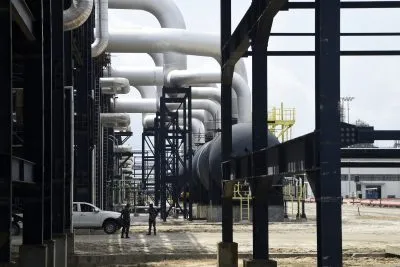In 1994, Rwandan cheesemaker Samuel Ndoli returned to his homeland at the end of his country’s civil war. “I was hopeful for a bright future,” said Ndoli, who built the East African country’s first post-war cheesery five years later in Rubavu, Lake Kivu.
Ndoli now provides an income to over 120 local farmers. His company Fromagerie la Reine utilises over 1,500 litres of milk, six days a week, to churn out freshly produced units of gouda, feta, cheddar, halloumi and ricotta, to 12 main buyers including a restaurant and hotel chain, supermarkets, and small quantities for export into neighbouring Democratic Republic of Congo and Burundi.
His popular mozzarella is meeting demand for a growing fast-food sector, as pizza deliveries gain popularity in Kigali.
“I dedicate one day a week to my family and the rest of the time I’m in my factory,” says the 69-year-old. “I’m passionate about transforming something raw into a value-added product. But I’m also proud of making new varieties of cheese that people here are not used to.”
Ndoli’s factory is equipped with modern machinery, allowing the cheesemaker to bring in revenues of $8,300 a month.
Approximately 75% of Rwanda’s 12.6m people rely for their income on agriculture, which forms the backbone of Rwanda’s economy. The Rwandan government has begun a drive for increased cheese quality to help boost flagging dairy exports.
The National Industrial Research and Development Agency (NIRDA) is embarking on a study to develop quality cheese that will investigate the quality of milk, processing machines, cow feed and transport.

Rethinking the market
There is a pressing need to rethink the market. Rwanda’s overall dairy exports, including milk, cheese, and yoghurt, dropped by 7,000 tonnes between 2018 and 2019, according to a report by the National Agricultural Export Development Board (NAEB). Rwanda currently imports more than 40 tonnes of cheese each year.
A 500g unit of imported Gouda cheese typically costs around $7 in an upmarket Kigali supermarket, while locally-made Gouda is sold at less than half that price.
Dairy constitutes 6% of Rwanda’s GDP but the sector faces a number of obstacles from cow to consumer, says Savio Hakirumurame, from the Ministry of Agriculture and Animal Resources.
Farmers lack adequate access to finance to procure modern machinery, despite the Rwanda Development Bank increasing loans to farmers by 118% between 2012 and 2017. Improvements are needed in animal genetics and nutrition, and the quality and reliability of cheeses and other dairy products needs enhancing.
“There is a quality scheme called S-mark that’s been introduced and it’s currently one of the market requirements to supply hotels, some restaurants and supermarkets,” says Hakirumurame.
“Of course cheese produced in Rwanda is of good quality and its appreciated by many, but a lot of effort is to be put into improving cheesemakers’ professionalisation in terms of good manufacturing practices, and in diversification of new cheese varieties. In terms of food safety, those who are S-mark certified are in a good position to export to other countries.”
Dairy farmers in Gishwati – one of Rwanda’s biggest milk-producing regions, manufacturing up to 90,000 litres per day – are expected to benefit from 93km of new feeder roads to help bring produce to market, funded by part of a $68m grant from the World Bank to improve infrastructure in the region.
Nigeria’s efforts to boost milk production falter
Lessons for agriculture from Covid-19: local is best
Africa’s agricultural sector faces up to Covid-19
A maturing industry
South Africa and Kenya are the two largest sub-Saharan consumers of cheese, and are part of a global market estimated at $70bn in 2019. South African cheese consultant Kobus Mulder has organised annual cheese festivals and workshops in Rwanda, Tanzania and elsewhere on the continent.
“A cow is a wonderful thing,” he says. “You can milk it on Wednesday and by Friday you’ve got food and money. If you plant beans you wait months. If you plant grapes or pears you’ll wait six or seven years. But if you give a person a cow you double his money almost immediately,” he says.
Rwanda’s national cattle herd was 1.3m in 2019, according to a report from the Dutch government. Agricultural products account for 63% of export earnings, and the contribution of milk to national GDP is projected to be $173m by 2022, as the Rwandan government seeks to move beyond subsistence farming towards a business-oriented, modern dairy sector.
About 20% of the Rwandan population is considered to be food insecure, and 38% live below the poverty line. The Rwandan population is growing at 2.3% per year, and demand for milk is growing along with the population. Yet consumption of other dairy products is rare and cheese is considered a luxury.
Mulder says that Africa produces roughly 145,000 tonnes of cheese annually, with production growing at 6% per year. The growth of the African cheese industry can improve nutrition and protein intake, and help lift more farming families out of poverty, but its success depends on creating a demand for cheese.
The continent’s cheesemakers need greater discipline to resist demands to sell immature cheese to buyers, which risks damaging its reputation, says Mulder. Instead, a widening culinary culture, growing recognition of outstanding African chefs and upmarket hotels will drive demand for artisan cheeses.
“There’s about 25 cheesemakers in Rwanda, local consumption is slowly growing and the government is behind cheese quality,” he says. “It’s a sign of confidence that banks are giving loans to buy new equipment, and if a government is behind cheesemaking and doesn’t meddle, but assists the cheesemaking industry, it can produce cheese, and good cheese.”
Raymond Siebrits, manager of South Africa’s Klein River Cheese Company, says that cheese consumption will increase in tandem with yoghurt, cream and milk consumption.
“When you see consumers start to explore more dairy products and put it on their weekly menus at home, then the market will mature. For artisan cheese in Africa, we need a city with 100 top-end restaurants and hotels to create that critical mass to grow demand.”
In Kigali, Innocent Karuranga founded the Cavabon cheese company as a way of preserving nutrients in milk. He specialises in making delicate blue cheese and camembert.
“The market in Rwanda is there, as more people adopt the dietary habits of European people,” says Karuranga.
His first cheesery was destroyed in 1994, and he went on to work in humanitarian missions with the Red Cross, but he is now negotiating a partnership with a group of European investors who have relocated to Rwanda.
Want to continue reading? Subscribe today.
You've read all your free articles for this month! Subscribe now to enjoy full access to our content.
Digital Monthly
£8.00 / month
Receive full unlimited access to our articles, opinions, podcasts and more.
Digital Yearly
£70.00 / year
Our best value offer - save £26 and gain access to all of our digital content for an entire year!
 Sign in with Google
Sign in with Google 



